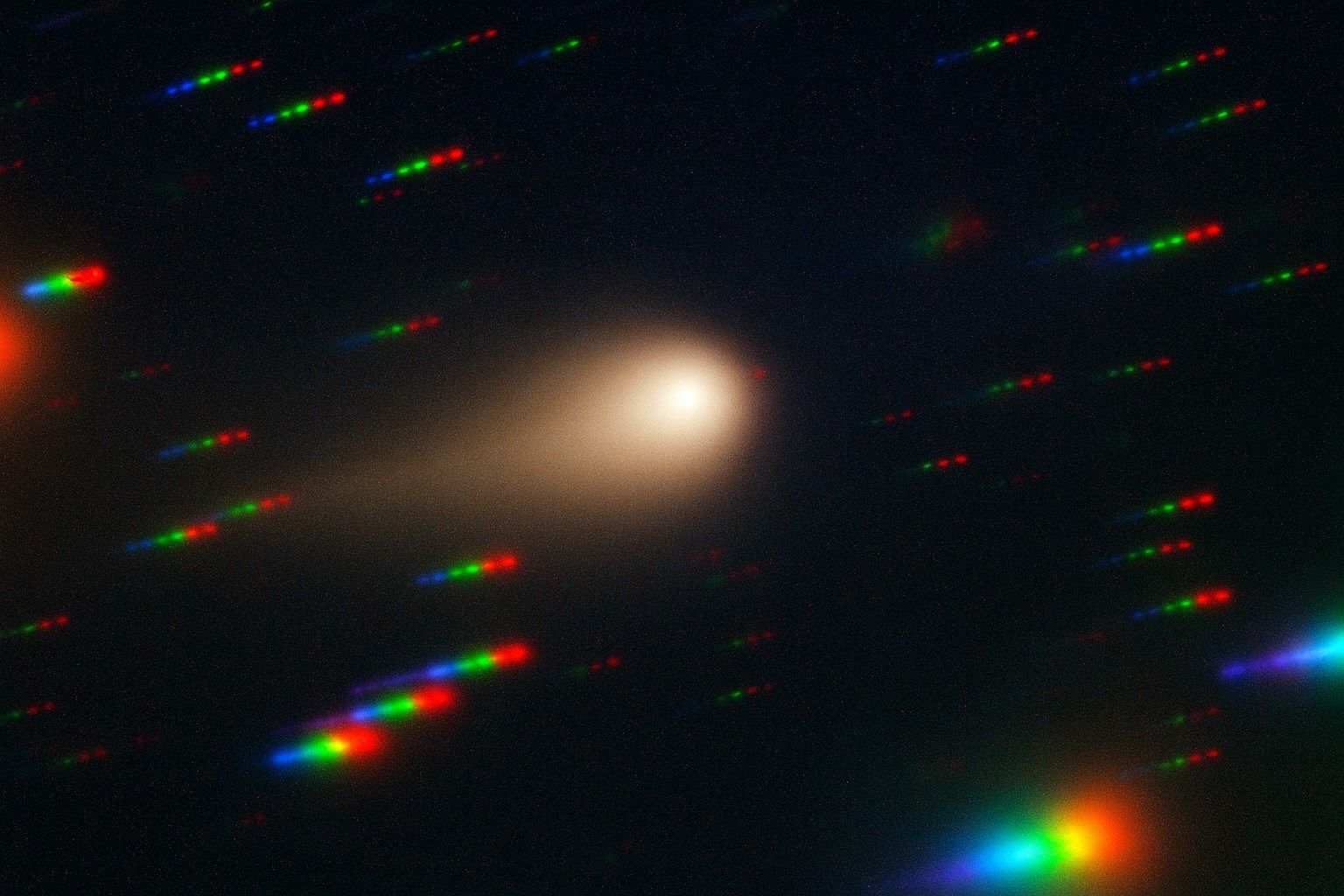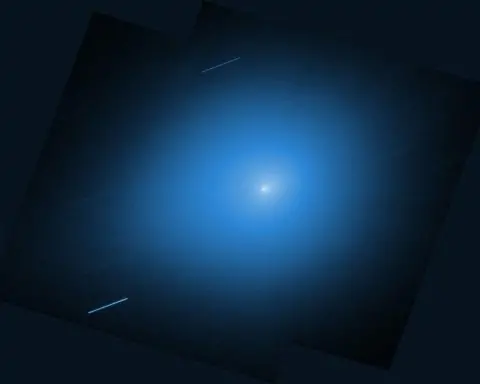Updated: November 11, 2025
Key points at a glance
- Back in view: Interstellar comet 3I/ATLAS has re-emerged into the pre‑dawn sky; experienced observers report it near Virgo, around magnitude +12 (telescope required). [1]
- Fresh imaging today: New images from the Virtual Telescope Project show a longer ion tail (≈0.7°) plus a visible anti‑tail, confirming rising post‑perihelion activity. [2]
- No “explosion”: Credible outlets debunk viral claims that the comet broke apart catastrophically. It appears normal and intact as it brightens and evolves after its late‑October perihelion. [3]
- Context from agencies:NASA reiterates 3I/ATLAS poses no threat to Earth; closest approach remains ~1.8 AU (~170 million miles) on Dec. 19, 2025. [4]
- ESA watch: European spacecraft have been (and will be) enlisted for observations, with JUICE viewing windows this month and data expected in early 2026. [5]
What’s new today
A longer, sharper tail. Astrophysicist Gianluca Masi reports that 3I/ATLAS’s ion tail has lengthened to at least 0.7°, with an anti‑tail also apparent in stacked exposures taken this morning (Nov. 11) from Italy. The session was conducted at low altitude above the eastern horizon under a bright Moon, underscoring just how active and structured the comet has become post‑perihelion. [6]
Visible again before dawn. As predicted, 3I/ATLAS has returned to the morning sky, now drifting through Virgo in the hours before sunrise. BBC Sky at Night Magazine notes that while it remains a faint, telescopic target (≈mag +12), it should gradually climb higher and head toward Leo over the coming weeks, making it easier to locate and image. [7]
Rumor control. A spate of social‑media posts and headlines claiming the comet “exploded” after its solar swing are not supported by current observations. Reporting today emphasizes that 3I/ATLAS appears intact; the evolving tail structures fit normal cometary behavior as sunlight drives outgassing of dust and volatiles. [8]
How to see 3I/ATLAS tonight (and through mid‑November)
- When: Look before dawn—3I/ATLAS rises ahead of the Sun.
- Where: Start in Virgo (low in the eastern sky), with the comet slowly trending toward Leo as the month progresses. [9]
- Gear: Plan on an 8‑inch (or larger) telescope or a capable smart scope; long‑exposure astrophotography will show more structure. [10]
- Expectations: It’s not a naked‑eye object. Under good transparency you may detect a small, diffuse “fuzzy” and, in processed images, hints of the ion tail/anti‑tail geometry seen by advanced imagers today. [11]
Science updates & what they mean
Tail physics, briefly. The ion tail points roughly away from the Sun under the solar wind’s influence; the visually surprising anti‑tail is a line‑of‑sight effect created by dust grains and viewing geometry. Today’s lengthening ion tail is typical as the comet recedes from perihelion yet remains active. [12]
Radio and space‑telescope context (recent). In the past 48 hours of coverage, outlets have highlighted a MeerKAT radio detection of hydroxyl (OH) absorption near 1665/1667 MHz—classic signatures of water breakdown in comet comae—supporting a natural, cometary explanation. While this particular detection was reported earlier this week, it frames today’s “no explosion” narrative with hard data consistent with normal outgassing. [13]
Agency posture.NASA’s public brief remains unchanged: 3I/ATLAS is the third confirmed interstellar object, on a hyperbolic path, and will not come near Earth (closest: ~1.8 AU on Dec. 19). ESA says ExoMars/TGO and Mars Express have observed the comet; JUICE is slated to contribute observations around now, with longer lead times for data return and analysis. [14]
Sorting fact from buzz (Nov. 11 media roundup)
- Confirmed today:Longer ion tail and anti‑tail seen in fresh imaging; 3I/ATLAS is observable before dawn in Virgo with sufficient aperture. [15]
- Debunked today: Reports of a dramatic post‑perihelion “explosion” or total breakup lack observational support; credible coverage stresses the comet looks normal and intact. [16]
- Reminder amid speculation: Despite sensational headlines elsewhere, mainstream guidance and agency material continue to categorize 3I/ATLAS as a comet exhibiting active jets and changing tails, not an alien craft. [17]
What’s next
- Best amateur imaging window: As 3I/ATLAS climbs through mid‑ to late November, imaging results should improve—particularly as it transitions toward Leo and gains altitude before dawn. [18]
- Calendar marker:Dec. 19, 2025—closest approach to Earth (~1.8 AU). It will still be far and will remain a telescopic target, but its higher altitude and ongoing activity could yield the most detailed amateur images of the apparition. [19]
- Spacecraft follow‑ups: Expect scientific papers and spacecraft datasets to trickle out over months; ESA notes that JUICE observations around this window won’t be available publicly until early 2026. [20]
Quick FAQ
Is 3I/ATLAS dangerous?
No. Its closest pass stays at roughly 1.8 AU—nearly twice the Earth–Sun distance. [21]
Why do the tails look “weird”?
Multiple jets, an ion tail, and an anti‑tail can appear simultaneously, driven by outgassing physics and viewing geometry—especially common around and after perihelion. Today’s images fit this pattern. [22]
Where do I point my telescope?
Start in Virgo before dawn and consult a planetarium app; the comet will migrate toward Leo through December. Expect a faint, fuzzy target near mag +12. [23]
Sources & further reading (today’s highlights)
- Virtual Telescope Project — “Interstellar comet 3I/ATLAS… the ion tail is getting longer – 11 Nov. 2025.” (Imaging report; ion tail ≈0.7°, anti‑tail visible). [24]
- BBC Sky at Night Magazine — “Comet 3I/ATLAS has returned to our morning sky. Here’s how you can see it.” (Observer’s guide; Virgo, ≈mag +12, pre‑dawn). [25]
- Live Science (Nov. 11) — “No, comet 3I/ATLAS hasn’t exploded — and no, that doesn’t mean it’s an alien spaceship.” (Rumor check; intact, normal post‑perihelion evolution). [26]
- NASA Science — “Comet 3I/ATLAS.” (Official overview; Dec. 19 closest approach ≈1.8 AU; safety). [27]
- ESA — “ESA’s ExoMars and Mars Express observe comet 3I/ATLAS” / JUICE observation window and data‑release timing. [28]
Editor’s note: A separate story circulating today concerns a newly discovered comet C/2025 V1 (Borisov) that some have wrongly linked to 3I/ATLAS; reputable coverage clarifies they are unrelated. If you see both in your feeds, that’s why. [29]
References
1. www.skyatnightmagazine.com, 2. www.virtualtelescope.eu, 3. www.livescience.com, 4. science.nasa.gov, 5. www.esa.int, 6. www.virtualtelescope.eu, 7. www.skyatnightmagazine.com, 8. www.livescience.com, 9. www.skyatnightmagazine.com, 10. www.skyatnightmagazine.com, 11. www.virtualtelescope.eu, 12. www.virtualtelescope.eu, 13. www.wired.com, 14. science.nasa.gov, 15. www.virtualtelescope.eu, 16. www.livescience.com, 17. www.skyatnightmagazine.com, 18. www.skyatnightmagazine.com, 19. science.nasa.gov, 20. www.esa.int, 21. science.nasa.gov, 22. www.virtualtelescope.eu, 23. www.skyatnightmagazine.com, 24. www.virtualtelescope.eu, 25. www.skyatnightmagazine.com, 26. www.livescience.com, 27. science.nasa.gov, 28. www.esa.int, 29. www.livescience.com










